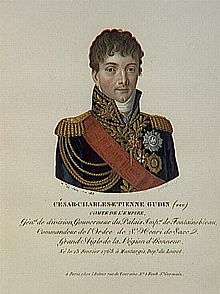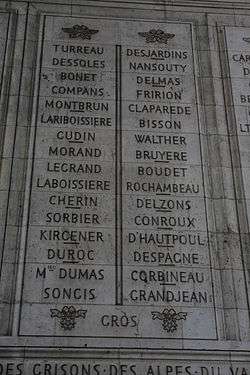Charles-Étienne Gudin de La Sablonnière
Charles-Étienne César Gudin de La Sablonnière (13 February 1768 – 22 August 1812) was a French general during the French Revolutionary Wars and Napoleonic Wars.[1]
Charles-Étienne Gudin de La Sablonnière | |
|---|---|
 General Gudin de la Sablonnière | |
| Born | 13 February 1768 Montargis, France |
| Died | 22 August 1812 (aged 44) Smolensk, Russia |
| Allegiance | |
| Years of service | 1782–1812 |
| Rank | General of Division |
| Commands held | Infantry |
| Battles/wars | French Revolutionary Wars, Napoleonic Wars |
| Awards | Count of the Empire |
| Other work | Governor of the castle of Fontainebleau |
Biography
An aristocrat by birth, Gudin who was born in Montargis, was admitted to the military school of Brienne and in 1782 entered the King's Guard. A lieutenant, he embarked for Santo-Domingo in 1791 and spent a year there, before returning to France in July 1792. He was appointed to several positions as a general staff officer in the Armies of the North, then of the Rhine-and-Moselle. He became a général de brigade at the beginning of 1799 and was given a command during the Swiss campaign. The following year he took part in the battles of Stein, Stockach, Messkirch, Memmingen, Höchstädt and Neuburg. Promoted to général de division for his valor on the battlefield, on 11 July 1800 he took Füssen.[1] That winter he commanded the 2nd division in the right wing under Lecourbe at the decisive French victory at Hohenlinden.

General Gudin de La Sablonière was given the command of the 3rd Division in the Grande Armée and fought in the wars of the Third Coalition and Fourth Coalition between 1805 and 1807. His 3rd Division of the III Corps was the first major formation into action at the battle of Auerstädt and it bore the main brunt of the fighting. It suffered 40 percent casualties one of whom was Gudin who was seriously wounded.[2] He participated in forcing the town of Custrin to capitulate and then playing an important part at the battles of Pultusk and Eylau. A count of the First French Empire in 1808, he was named governor of the castle of Fontainebleau the following year. He then took part in several battles of the War of the Fifth Coalition: Thann, Landshut, Eckmühl, the taking of Ratisbon. He was wounded at the great battle of Wagram. In 1812 he was given the command of a division of the second Grande Armée.[1] He was struck by a cannonball during the battle of Valutino, fighting against Russian troops near Smolensk in Russia. His leg was amputated but he developed gangrene and died three days after the battle.[3][4] However, his heart was taken out to be buried in a chapel in the Père Lachaise Cemetery, Paris.[5]
On 6 July 2019, in a park in central Smolensk, archaeologists led by French historian Pierre Malinowski[6] found a coffin and skeletal remains that bore signs of trauma consistent with the historical record of Gudin's death (one leg amputated and another one wounded)[7].[5][8] The find was confirmed when DNA tests from the remains found in Russia matched those of Pierre-César Gudin, Charles-Etienne Gudin's brother who was also a Napoleonic general.[4]
Family
Gudin married Jeanne Caroline Christine Creutzer the sister of Brigadier-General Charles Auguste Creutzer (1780–1832).[9]
Recognition
His name appears on the Arc de Triomphe in Paris.[1][3]
References
Citations
- Fierro, Palluel-Guillard & Tulard 1995, p. 821.
- Chandler 1993, p. 68.
- Mullié 1851, p. 33.
- "Skeleton find in Russia may be Napoleonic general". BBC News. 29 August 2019. Retrieved 7 November 2019.
- "Remains of one of Napoleon's 1812 generals believed found in Russia". Reuters. 9 July 2019.
- "Mystery of Napoleon's missing general solved". BBC News. 2019-11-07. Retrieved 2020-07-28.
- Samuel, Henry (2019-11-06). "One-legged skeleton found under Russian dance floor is Napoleon's 'lost general', DNA tests confirm". The Telegraph. ISSN 0307-1235. Retrieved 2020-07-28.
- "Найденные в Смоленске останки могли принадлежать наполеоновскому генералу Гюдену" [The remains found in Smolensk could belong to the Napoleonic General Guden]. TASS (in Russian). 8 July 2019.
- Henner 1999.
Sources
| French Wikisource has original text related to this article: |
| Wikimedia Commons has media related to Charles Etienne Gudin de la Sablonnière. |
- Chandler, David (1993), Jena 1806: Napoleon Destroys Prussia, Osprey Military Campaign Series, 20 (illustrated, reprint ed.), Osprey Publishing, p. 68, ISBN 9781855322851
- Fierro, Alfredo; Palluel-Guillard, André; Tulard, Jean (1995), Histoire et Dictionnaire du Consulat et de l'Empire (in French), Paris: Robert Laffont, p. 821, ISBN 2-221-05858-5
- Henner, Gérard (1999), Pour Dieu et pour le Roi: le combat pastoral et "politique" de Jean Jacques Weber (1767-1833), archiprêtre de Volmunster et de Rohrbach (in French), Confluence, ISBN 9782909228112
- Mullié, Charles (1851), , Biographie des célébrités militaires des armées de terre et de mer de 1789 à 1850 (in French), p. 33